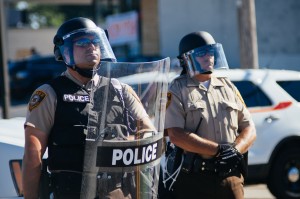“What are you in for?”
“Resisting arrest.”
aNewDomain — We’ve always known this was bullshit, circular reasoning at its worst.
 If the only thing on your sheet is resisting arrest, then they arrested you for no reason. It’s kind of like calling someone to get their phone number, or needing your actor’s card to get enough parts for your actor’s card.
If the only thing on your sheet is resisting arrest, then they arrested you for no reason. It’s kind of like calling someone to get their phone number, or needing your actor’s card to get enough parts for your actor’s card.
Take a philosophy class. If logic is in there anywhere, and it’s likely to be, you’ll talk about the logical fallacy called non causa pro causa — or “non cause for cause.” That’s a logical fallacy. It implies that something is the cause of something else, when really it isn’t.
The usual example illustrating “non cause for cause” is this: A posse rides out to arrest Phil. Phil sees the posse coming and legs it. The posse chases him and arrests him. At his trial, he’s found guilty — because he ran.

There are lots of reasons someone might run when confronted with a posse. In the above example, they never bring up the idea that Phil might be black, the posse white, and police guilty of decades or even centuries of racial harassment.
In other words, Phil knows no good is going to come of this. They were going to find him guilty, anyway. So he split.
Did cops acting badly cause the riots in Baltimore?
 Michael Wood, Jr., isn’t likely to get any love from his fellows. He’s a former officer on the Baltimore police force who has begun Tweeting the things he says he saw during this April’s protests against police brutality in Baltimore.
Michael Wood, Jr., isn’t likely to get any love from his fellows. He’s a former officer on the Baltimore police force who has begun Tweeting the things he says he saw during this April’s protests against police brutality in Baltimore.
Wood also has some things to say about the routine business of white guys policing black folk, which he says included defecating on people’s beds during searches, slapping women, and arresting black people just because that is what you do.
Such claims need corroboration, at least for those who aren’t hassled by cops every day. Wood might have some beef against one of his bosses or the department, or some other reason to say these things beyond provoking a conversation about policing practices.
And yet…
In a recent Gallup poll, one in four black men under 35 says they have been unfairly treated by police in the past month. Polls aren’t the best way to get evidence, but they’re certainly suggestive.
Take that along with this: New York police stop-and-frisked people of color about 4 million times since 2002, all based on them looking “suspicious.” In studied where researchers take field samples of such practices, virtually no white people are on the wrong side of this.
So what you’ve got is about 307,000 searches a year based on skin color. But after courts ruled the practice unconstitutional, stop-and-frisk is no longer official policy of the New York Police Department. We don’t have data yet on whether the policy change has resulted in practical change.
 The days of ticket quotas are officially over, too. But police still get productivity reports, says this Slate article. One consequence of that is lots of tickets for black cyclists in a high-crime neighborhood.
The days of ticket quotas are officially over, too. But police still get productivity reports, says this Slate article. One consequence of that is lots of tickets for black cyclists in a high-crime neighborhood.
Biking While Black (BWB)
Just as with driving a car, biking while black is in invitation to be stopped, asked for consent for a search, and then searched, anyway, because failing to consent provides probable cause to bring out a drug dog.
A city like Ferguson funds its government on the backs of the poor, people who cannot afford to pay their fines, never mind go to court to contest them. John Oliver renders this down to steamy mush for us here.
 That the poor people in question are usually black was a contested issue until the Justice Department investigated it and found all such claims wholly substantiated.
That the poor people in question are usually black was a contested issue until the Justice Department investigated it and found all such claims wholly substantiated.
Harassment happens every day, in every way.
This April a video watched by the world shows a black man in South Carolina being shot dead in the back by a cop while running away. After Walter Scott fell to the ground, Officer Michael T. Slager staged the scene to look like a confrontation, planting a weapon near the body. Officer Slager has been charged with murder.
But this has been going on forever, the age of lynchings ongoing. (Bruce Springsteen released a song called “American Skin” about a kid being shot 41 times by police. Some people sure didn’t appreciate him much for that.)
The video below shows what the non-cause-for-cause problem looks like. A black man tries to pick up his kids from school. Someone calls 911 because he looks suspicious. The police try to get him off the property. Things escalate quickly.
Finally, when all reason has failed, the man loses control and calls the cops “racist motherfuckers.” By this time Chris Lollie has already been tased for trying to get his kids and not going along with intimidation and harassment. But now his words give the police have a reason to charge him with disorderly conduct and other spurious accusations.
Those charges were later dropped. But if not for the video that showed what really happened, would Chris Lollie be rotting in jail right now?
Here’s the video.
So here’s how it works …
First, we have systematic inequality and a justice system that makes its living on black incarceration, a political system that gets tough on crime by parading black criminals across white consciousness. Police spend undue time in black neighborhoods, harassing, exploiting, and even assaulting people of color.
Implicit bias tests find that black men holding ambiguous objects are 11 times more likely to be shot by police than white ones.
The police will stop, frisk and cite black men who seem suspicious, but with the lens of racial bias on, every black man seems pretty suspicious to them. And when they stand on their rights, they’re resisting and get arrested. When they know they’re getting arrested no matter what and decide to leg it, they’re resisting and they get arrested – or shot.
When police have no reason to arrest someone, the interactions that occur before the cameras are on might include harassment and provocation. Then, when we find out that rates of black assault and excessive force by police vastly exceed white excessive force, we blame the victims.
The difference, we say, is that white people stay calm, hold out their hands for cuffs, and cooperate.
That’s why Eric Garner was strangled to death in public and the only one who did jailtime was the guy who caught the murder on tape. But Dylann Storm Roof was given a vest — and a drive-through burger?
The argument is the not-cause for cause argument. And that’s a fallacy.
For aNewDomain, I am Jason Dias.
Image one: “Photogravure from the painting by B. Knupfer in Dusseldorf Gallery” [Public domain], via Wikimedia Commons
Image two: OVMCowboys.ca, All Rights Reserved
Image three: Ex Baltimore Police sergeant Michael Wood hugging Baltimore citizens on the street via PopularResistance.org, All Rights Reserved.
Image four: Riot police in Ferguson, MO by Jamelle Bouie [CC BY 2.0], via Wikimedia Commons
Image five: Ticket quota sign in Florida, via Blog.Motorists.org, All Rights Reserved.













